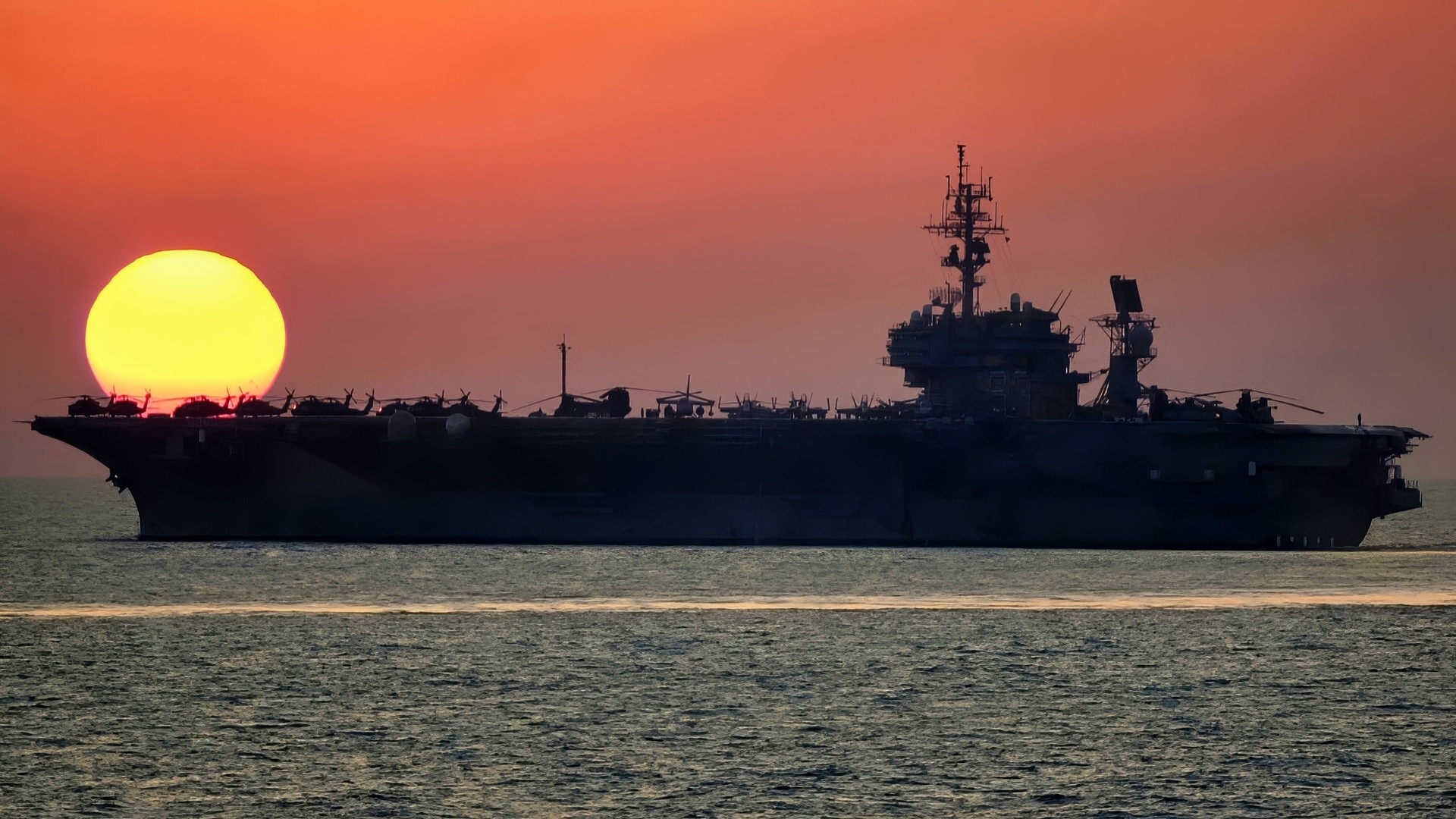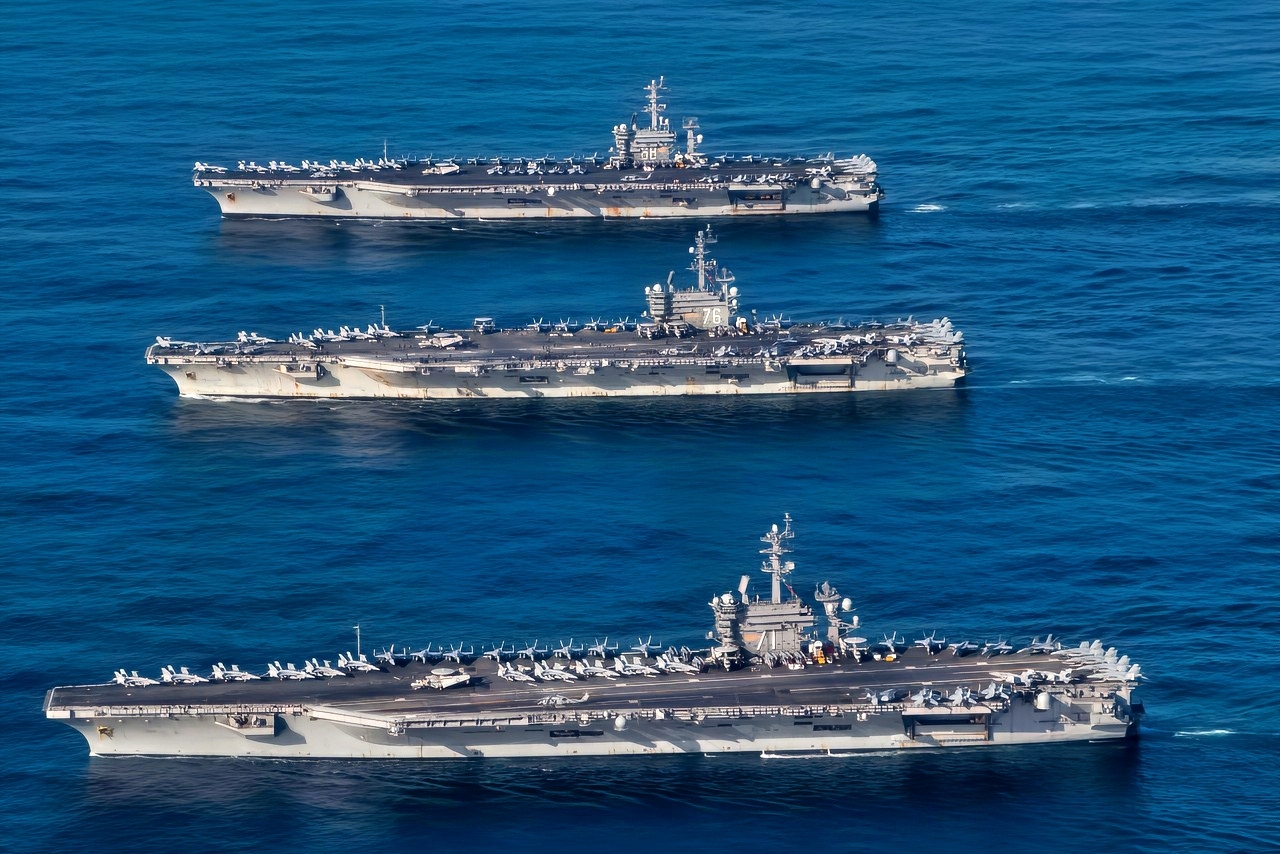Key Points and Summary – In March 1984, Soviet Victor-class submarine K-314 was shadowing the USS Kitty Hawk aircraft carrier group during Exercise Team Spirit in the Sea of Japan.
-Bad weather and poor sonar conditions caused the sub to lose contact. When Captain Vladimir Evseenko surfaced to periscope depth, the carrier group was already closing.

USS Kitty Hawk of Kitty-Hawk-Class. Image Credit: Creative Commons.

The U.S. Navy aircraft carriers USS Nimitz (CVN-68), USS Theodore Roosevelt (CVN-71) and USS Ronald Reagan (CVN-76) underway in the Western Pacific on 12 November 2017. The strike groups were underway and conducting operations in international waters as part of a three-carrier strike force exercise. This was the first time since August 2007 that three U.S. Navy carriers operated together. In 2007, USS Kitty Hawk (CV-63), USS Nimitz (CVN-68) and USS John C. Stennis (CVN-74) participated in exercise “Valiant Shield”.
-At 22:07, Kitty Hawk struck the submarine, mangling K-314’s propeller and gashing the carrier’s bow, spilling jet fuel but causing no casualties.
-Both nuclear-armed vessels chose restraint. The U.S. quietly recovered pieces of the sub’s propeller and anechoic coating, turning a dangerous collision into unexpected intelligence gain.
The Night a Soviet Submarine Crashed Into a U.S. Supercarrier
The Cold War was full of near misses and close calls that almost triggered a full-scale nuclear war between the United States and the Soviet Union. Some of these near misses were far less dramatic than, say, the Cuban Missile Crisis, but were nevertheless tense moments that threatened to break down the thin diplomatic relations between the U.S. and USSR.
In one such occasion, a Soviet Victor-class submarine collided with a U.S. carrier during a routine American exercise in the Sea of Japan.
Thankfully, the event was resolved peacefully and remained relatively low-profile
Spying on an American Aircraft Carrier
The incident occurred during Exercise Team Spirit 84, a large-scale joint U.S.–South Korean military drill in the Sea of Japan. These exercises were intended to demonstrate allied readiness and deter aggression from North Korea, while also signaling strength to the Soviet Union.
For Moscow, such maneuvers near its Far Eastern borders were provocative, prompting the Soviet Pacific Fleet to dispatch submarines to shadow and monitor U.S. naval movements. Among these was K-314, commanded by Captain Vladimir Evseenko, whose mission was to track the Kitty Hawk Carrier Strike Group.
From March 14, 1984, K-314 began shadowing the Kitty Hawk and its escorts. The carrier strike group included the 80,000-ton Kitty Hawk, which carried more than 80 aircraft and was accompanied by eight warships.

USS Ronald Reagan (CVN 76), USS Kitty Hawk (CV 63), and USS Abraham Lincoln (CVN 72) cruise side-by-side in the Philippine Sea June 18, 2006, during exercise Valiant Shield 2006. The joint exercise consists of 28 naval vessels, more than 300 aircraft, and approximately 20,000 service members from the Navy, Army, Air Force, Marine Corps and Coast Guard. (U.S. Navy photo by Chief Photographer’s Mate Spike Call) (Released)
For several days, the Soviet submarine maintained pursuit, attempting to remain undetected while gathering intelligence on U.S. antisubmarine warfare tactics. The Americans, aware of the submarine’s presence, launched helicopters and deployed sonobuoys to track it.
Reports indicate that U.S. forces “killed” the submarine in simulated attacks more than 15 times during this period.
That Time a Soviet Sub Hit a Supercarrier
The situation grew more precarious as bad weather swept across the Sea of Japan. Heavy seas and deteriorating sonar conditions caused K-314 to lose visual contact with the carrier group.
Seeking to reestablish situational awareness, Captain Evseenko ordered the submarine to rise to periscope depth, approximately 10 meters below the surface, on the night of March 21, 1984.
What he saw through the periscope was alarming: the entire Kitty Hawk strike group was only four to five kilometers away, closing fast. Both vessels were on converging courses at significant speed.
At 22:07 local time, near coordinates 37°3′N, 131°54′E, roughly 150 miles east of Pohang, South Korea, disaster struck. Despite an emergency order to dive, K-314 could not avoid the massive carrier barreling toward it.

Victor III-Class Submarine. Image Credit: Creative Commons.
The USS Kitty Hawk, steaming at 15 knots with navigation lights on, plowed into the submarine.
Sailors aboard the carrier felt a noticeable shudder and a fairly violent shudder, according to Captain David N. Rogers, Kitty Hawk’s commanding officer.
Evseenko later recalled his first thought: “The conning tower had been destroyed and the submarine’s body was cut to pieces.”
Miraculously, K-314 remained intact, though the collision inflicted severe damage. The submarine’s propeller was mangled, and its stabilator bent, rendering it incapable of independent propulsion. Kitty Hawk, meanwhile, suffered a gash in its bow, which caused thousands of gallons of jet fuel to spill into the sea, a near-catastrophic hazard given the carrier’s aviation operations and onboard ordnance.
Aftermath: Another Near Miss
Following the collision, Kitty Hawk halted operations and launched SH-3H Sea King helicopters to assess the situation. Using night-vision goggles and sonobuoys, U.S. crews inspected the Soviet submarine, which had surfaced and was accompanied by the Soviet missile cruiser Petropavlovsk.
Despite American offers of assistance, the Soviets declined, maintaining radio silence and signaling their intent to handle the crisis independently. The U.S. Navy stood by, prepared to render aid, while simultaneously recovering debris from the collision.
Among the items retrieved was a fragment of K-314’s propeller and pieces of its anechoic coating, a sound-absorbing material critical to submarine stealth. This unexpected intelligence windfall provided U.S. analysts with valuable insights into Soviet submarine technology.
Although no lives were lost, the incident can be best described as a diplomatic near miss. Both vessels carried nuclear weapons, and a more severe collision could have triggered explosions or radioactive contamination. In the charged atmosphere of 1984 marked by President Reagan’s military buildup and Soviet paranoia, the collision could easily have escalated into a diplomatic crisis or even armed conflict. Instead, both sides opted for restraint.
The Kitty Hawk resumed operations shortly after the collision, while K-314 awaited tow assistance from Soviet vessels. Official statements from Washington and Moscow were terse, attributing the mishap to navigational error. U.S. officials privately questioned the seamanship of the Soviet captain, noting that international maritime law obliges submarines to give way when surfacing and to display navigation lights, rules K-314 had evidently ignored.
The collision highlighted several operational realities of Cold War naval warfare. It demonstrated the limitations of sonar, as submarines are acoustically “blind” at their stern due to engine noise. This factor likely contributed to K-314’s failure to detect the carrier before surfacing.
It also revealed the risks inherent in close shadowing, a tactic emphasized by Soviet doctrine but dangerous in poor weather.
The U.S. exploitation of recovered Soviet submarine materials exemplified how even accidents could yield strategic advantages. Finally, the incident reinforced the importance of procedural rigor in submarine operations, as Evseenko’s choice to surface without a thorough sonar sweep proved costly.
About the Author: Isaac Seitz
Isaac Seitz, a Defense Columnist, graduated from Patrick Henry College’s Strategic Intelligence and National Security program. He has also studied Russian at Middlebury Language Schools and has worked as an intelligence Analyst in the private sector.
More Military
The U.S. Navy’s Constellation-Class Frigate Crisis Keeps Getting Worse
China’s New H-20 Stealth Bomber Might Have a 10,000 km Range
Even Mach 3 Speeds Could Not Save the Titanium SR-71 Blackbird
The U.S. Navy’s New DDG(X) Destroyer Is Sailing Into Stormy Waters










